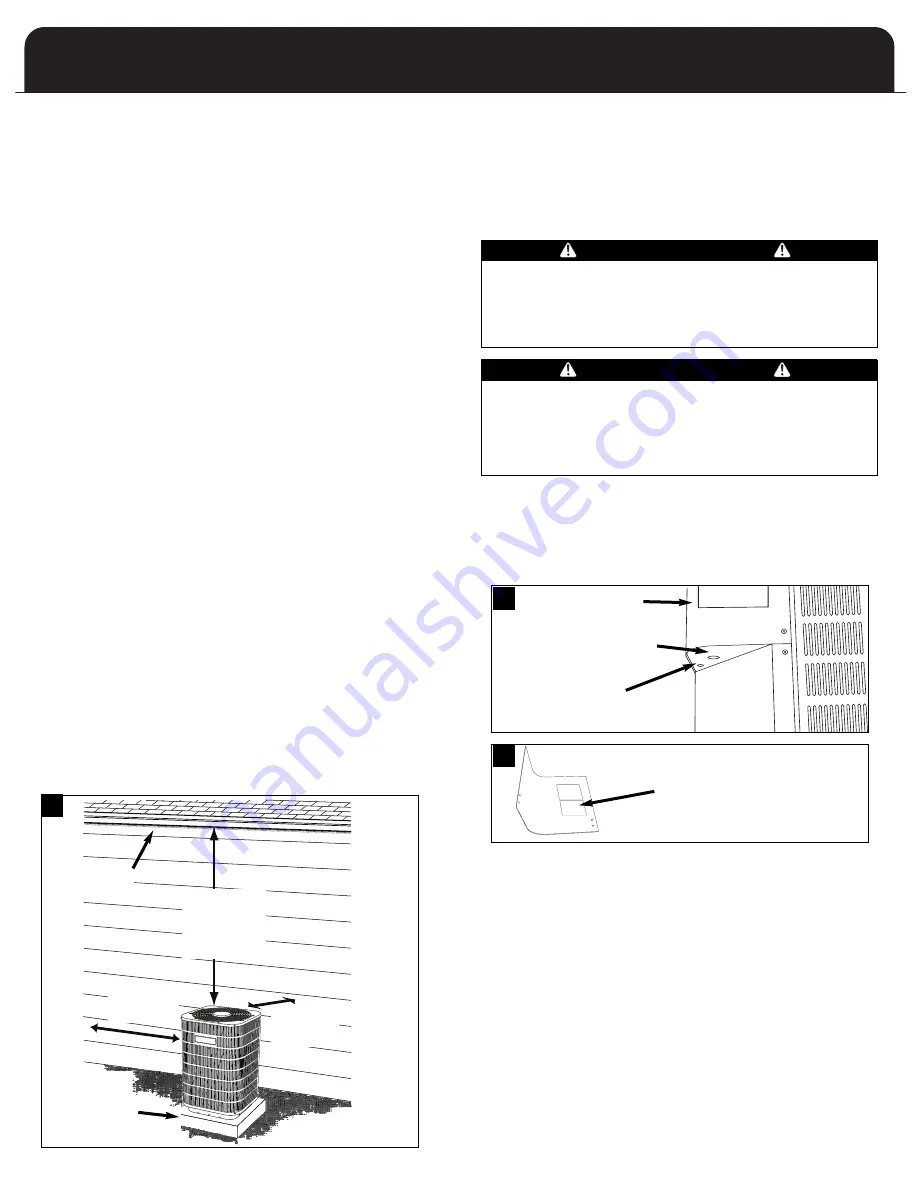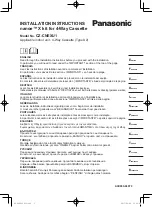
2
6'
clearance
above the
unit
3'
clearance
Rain Gutters
Concrete slab
or preformed pad
12"
clearance
INSTALLATION
Condensing Unit Location
The condensing unit should be located outdoors as close as
possible to the evaporator. Consider the following factors:
Clearances
The air inlet should be located at least 12" from a wall or
other obstruction for unrestricted air flow.
The air outlet should be located so as to direct discharged
air away from the building. Three feet of clearance around
the unit and a minimum of six feet clearance above the
unit is required to avoid recirculation of condenser
discharge air on vertical discharge models. Avoid locating
unit under low overhanging roofs.
Support
Mount the unit on a sturdy base approximately four to six
inches above the ground. In areas known for snow
accumulation, the unit should be elevated at least 18"
above the ground. A concrete slab is recommended.
Concrete slab should not contact the building foundation
to prevent possible sound or vibration transmission.
Rooftop installation is acceptable in areas of low snow
accumulations, provided the roof will support the unit and
provisions are made for water drainage and the noise or
vibration through the structure.
Exposure
Placement of the unit should be in a well-drained area, or
the unit must be supported high enough so run-off will not
enter the unit.
Avoid installations under roof overhangs without
guttering. Water draining from the roof onto the unit
could produce excessive noise and may cause ice to build
up on the coil or fan during cold weather.
Locate unit away from windows, patios, decks, etc. where
unit operation sound may disturb customer.
Do not locate where heat, lint or exhaust fumes will be
discharged on the unit (as from dryer or furnace vent).
Proximity to Evaporator
Locating the condenser as close as possible to the
evaporator will increase the system capacities by reducing
the line set refrigerant pressure drop, and will make the
system less susceptible to liquid migrations due to less
refrigerant charge.
1. The installer shall check available power to make certain it
matches the unit rating plate (located inside control box
cover) and that constant voltage can be maintained to the
unit. Unsatisfactory performance would otherwise result.
The local power company should be contacted regarding
any problems or questions concerning power supply.
Electrical Connections
WARNING
ELECTRICAL EQUIPMENT SHOULD BE INSTALLED BY A
QUALIFIED, LICENSED ELECTRICIAN. IMPROPER
ELECTRICAL HOOK-UP MAY DAMAGE EQUIPMENT, CAN
CREATE A HAZARD, CAUSE PERSONAL INJURY OR
DEATH, AND WILL VOID THE WARRANTY.
DANGER
BEFORE PERFORMING ANY WORK ON THIS EQUIPMENT,
POWER SUPPLY MUST BE TURNED OFF AT THE HOUSEHOLD
SERVICE BOX TO AVOID THE POSSIBILITY OF SHOCK,
INJURY, DEATH OR DAMAGE TO EQUIPMENT.
Control box cover
Wiring diagram and rating
plate are located inside
control box cover
Opening for
low-voltage wiring
Opening for line
voltage conduit or cable
2. Install a line service disconnect switch within sight of the
condensing unit. The line voltage service wiring for the
condensing unit should include a fused disconnect switch.
3. Use correct wire size and fuse size. To ensure that adequate
voltage will be available at the condensing unit, the line
voltage service wiring must be of adequate size. Minimum
recommended wire ampacities and maximum fuse sizes are
listed on the unit name plate.
4. Two holes are provided in the control box.
a. One is for the connection of the line voltage conduit or
cable. The hole is sized for 3/4" conduit.
b. One is for low-voltage wiring. (Refer to the wiring
diagram attached to electrical box cover for connection.)
5. Be sure to ground the condensing unit by securing the
ground wire to the grounding lug inside the control box.
6. Be sure to follow National Electrical Code and all local
codes.
11
1
11
2
11
3
on 3 side
to wall


























